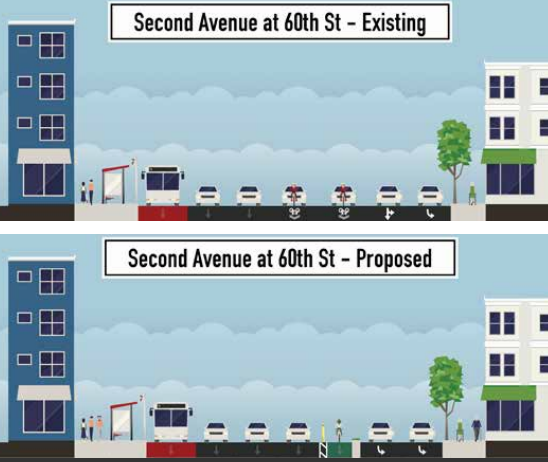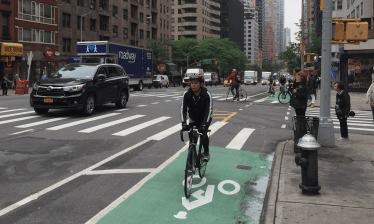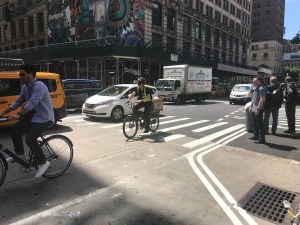How to Close the Second Avenue Bike Lane Gap

Last year, DOT made substantial progress on the protected bike lanes along First Avenue and Second Avenue in Manhattan, and the agency plans to protect 16 more blocks of Second Avenue in Midtown. But even after that project wraps up, there will still be two major gaps where the Second Avenue protected bike lane approaches the Queensboro Bridge and the Queens Midtown Tunnel.
In a new report, Transportation Alternatives makes the case for closing these gaps as soon as possible and lays out a design concept for the tricky approach to the Queensboro [PDF].
Second Avenue is one of the most dangerous streets in Manhattan, according to DOT’s pedestrian safety action plan. On the 18 blocks with no protected bike lane on the ground or in the works (68th Street to 59th Street, and 42nd Street to 34th Street), an average of 110 people are injured each year, according to data compiled by T.A.
The city first announced plans to put protected bike lanes on First Avenue and Second Avenue seven years ago, but implementation has proceeded in fits and starts since the first segments were installed in 2010.

Members of Manhattan community boards 6 and 8 are on the record asking for a protected bike lane along all of Second Avenue. “I want you to look at creative ideas because we know that there’s not an easy solution at the Queensboro Bridge,” frustrated CB 8 transportation co-chair A. Scott Falk told DOT reps last January.
“We’ve got on record several resolutions in which we had advised about the problems of providing [sharrows],” CB 6 transportation committee member Larry Scheyer said in March.
DOT officials have hesitated to claim space for bicycling where car traffic is very intense, arguing that motor vehicle throughput should take precedence.
TA envisions extending the curbside protected bike lanes from 68th Street to 63rd Street. From there the bike lane would shift to the right of left-turning traffic heading to the FDR Drive and the Queensboro. It would be separated from turning traffic by a concrete median and from through traffic by flexible bollards.
The concept is very similar to a recent DOT safety improvement at Third Avenue and 57th Street, where the agency installed a concrete bus boarding island between turning traffic and through traffic:

TA concludes:
The proposed design for the gap on Second Avenue near the Queensboro Bridge is an easily replicable, affordable option to protect cyclists traveling at this dangerous intersection. Given the high number of traffic injuries that have occurred on Second Avenue in recent years, we have no time to waste. Transportation Alternatives urges the NYC Department of Transportation to overcome its misgivings and fill the gaps in the Second Avenue bike network today.

